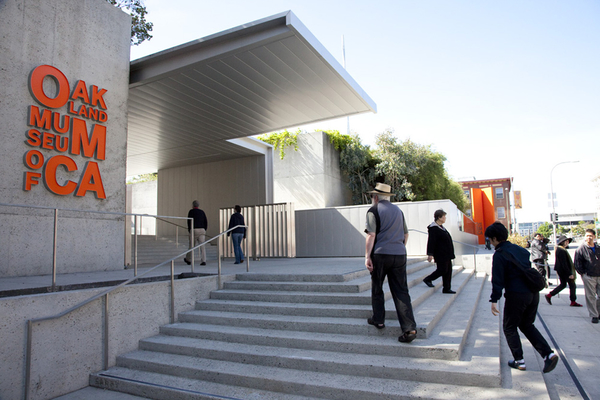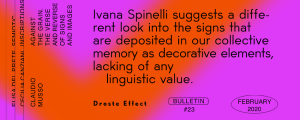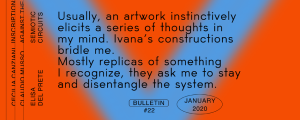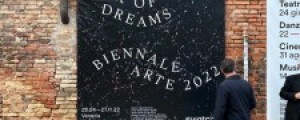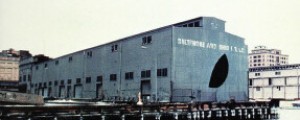A Walk Through the Oakland Museum of California’s Art Collection
Designed by Pritzker Prize-winning architect Kevin Roche in 1969 and situated between Lake Merritt and Downtown Oakland, the Oakland Museum of California (OMCA) is a major architectural example of mid-century modernism in the United States as well as one of the most vibrant museums in the San Francisco Bay Area.
With the reopening of the Gallery of California Science in May 2013, the museum celebrated the completion of a seven-years and $63 million transformation of its 300,000 square-foot complex. The renovation project consisted on the one hand in the enlargement and revaluation of the existing galleries, theater, terraced roof garden and central courtyard, and on the other hand in the creation of a new research center and of a public café service. Beside this massive architectural metamorphosis, the museum experienced a radical methodological shift inspired by Lori Fogarty—OMCA’s Executive Director since March 2006—who introduced an inclusive curatorial approach based on civic engagement and participation. In its new structural and conceptual configuration, the Oakland Museum of California meets the diverse purposes of an exhibition venue, an urban park, a conservation and storage facility, and an open discussion platform for the local community.
The OMCA’s collection represents another unique feature of this polyvalent and forward-thinking museum. Comprising more than 1.8 million objects among artworks, historical artifacts, ethnographic materials, natural specimens, and photographs, it came together through the fusion of three small, early 20th-century museums: the Oakland Public Museum, the Oakland Art Gallery, and the Snow Museum of Natural History. In order to preserve the uniqueness of each collection and, at the same time, to bring out the interrelationship between each object, the museum established three distinctive exhibition spaces: a Gallery of California History, a Gallery of California Art, and a Gallery of California Science. Through this multidisciplinary approach, the Oakland Museum of California aims to investigate and to present the social, cultural, and environmental heritage of California as a unique, multifaceted territorial reality.
The Gallery of California Art features an ever-changing selection of paintings, photos, installations, and design products offering a 360 degree-look at the artistic production in and about California from the 19th century to the present. My visit starts with the meeting of Senior Curator of Art René de Guzman. A longtime Bay Area resident, de Guzman immigrated to the U.S. from the Philippines in 1968. Before pursuing a curatorial career, he earned a Bachelor of Fine Arts at the University of California, Berkeley in 1987, and worked for several years as a visual artist. In 2007, he joined the OMCA’s team as overall project manager for the Gallery of Art and played an essential role in the overall innovation process that led to the development of a new curatorial strategy just before the reopening of the museum in 2010. One of his main accomplishments consisted in the reorganization of the art collection around three major themes: California Land, California People, and California Creativity. For each theme he then created a specific gallery section dedicated to the artistic response to California’s natural and man-made landscape, California’s heterogeneous population and culture, and California’s open and generous approach to art and art-making, respectively. This thematic versus chronological arrangement brings side by side works in different media and from different periods, highlighting the richness and diversity within California’s visual tradition. Moreover, it reflects de Guzman’s notion of visual art as a fundamental instrument for storytelling.
Beside reorganizing the Gallery of California Art in a Land, a People, and a Creativity section, de Guzman strove to make the exhibition space as welcoming and inclusive as possible, introducing specific tools that facilitate the interaction between the public and the displayed artworks. These tools include first-person voice and multilingual labels (English, Spanish, and Chinese); movable chairs that allow visitors to sit in front of a specific artwork and view it with greater attention; interactive journals to encourage dialog between audience and curators; and gathering areas, called “loaded lounges”, designed to provoke conversation among visitors about major art-related issues.
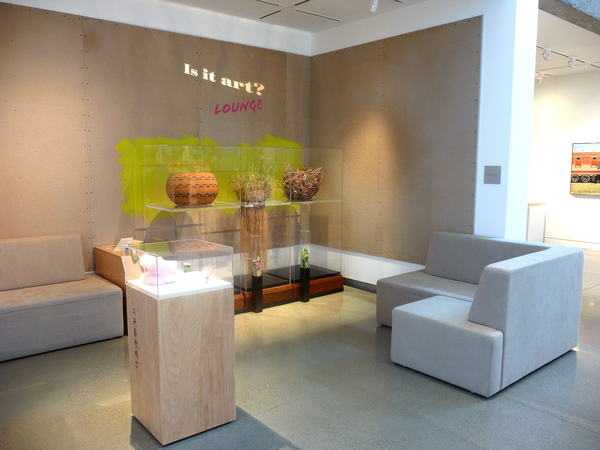
One of the “Loaded Lounges” located in the Gallery of California Art. Photo: Rue Flaherty. © Oakland Museum of California.
Inspired by his fresh vision on collection management and public engagement, I asked René de Guzman what the most representative artwork of each gallery section is in his opinion. In response, he points out a photography collage by Mark Klett and Byron Wolfe, a sculpture by Sam Durant, and the so-called “Portrait Wall”, a multimedia installation that brings together work by Robert Arneson, Carmen Lomas Garza, David Park, and Carrie Mae Weems, among many others.
The photography collage entitled Above Lake Tenaya, connecting views from Edward Weston to Eadweard Muybridge is a collaborative work by American photographers Mark Klett (°1952) and Byron Wolfe (°1967). Both played a decisive role in the development of landscape photography and the environmental movement in California in the 1970s. During the past two decades, Klett and Wolfe conducted a large exploration and reconstruction project consisting in the integration of early landscape photographs of some of California’s most celebrated natural treasures in their own contemporary work. This particular piece, featured in the Gallery of Art’s Land section, connects two pictures by Edward Weston (left) and Eadweard Muybridge (right), both taken in Yosemite National Park respectively in 1936 and 1872, creating a visual as well as a metaphorical bridge across time and space.

Mark Klett and Byron Wolfe, Above Lake Tenaya, connecting views from Edward Weston to Eadweard Muybridge, 2002. Inkjet print, 24 x 103 in. Left: Edward Weston, Juniper, 1936 (Courtesy the Center for Creative Photography, University of Arizona); right: Eadweard Muybridge, Ancient Glacier Channel, at Lake Tenaya, Mammoth Plate No. 47,” 1872 (Courtesy The Bancroft Library, University of California, Berkeley). Collection of the Oakland Museum of California, Art Acquisition Fund.
Sam Durant’s work, entitled Proposal for a Monument to Huey Newton at the Alameda County Courthouse, Oakland, CA, featured in the Gallery of Art’s Creativity section, represents an important evidence of California’s recent history. It consists of the bronze replica of a 19th-century ‘wicker fan back chair’ pictured in an iconic portrait of Huey Newton, co-founder of the Black Panther Party, displayed on the wall next to the installation. Established in Oakland in 1966 to protect the Black American community from police brutality, the Black Panther Party eventually merged with leftish movements all over the world and became a symbol of the counterculture of the 1960s and 1970s. Despite its pacifistic connotation, however, the group’s political goals were often overshadowed by the radical and frequently violent conduct of its members. Therefore, perhaps, when Sam Durant proposed to place this work in front of the Alameda County Courthouse—the building where all Black Panther trials were conducted, which is located right across the street from the OMCA—to serve as a monument of the liberation struggle in America, his request was denied. Senior Curator of Art René de Guzman then came up with the idea to exhibit it in a recently annexed area of the Gallery of California Art in proximity of a large window which looks out right to the Courthouse building. This way, the observer can enjoy the view of both the sculpture and the architectural environment it was meant to be part of at the same glance. Visitors are invited to interact with this work by sitting on the chair and reflecting—as the mirroring surface of the sculpture’s steel base literary suggests—about the need of personal and social freedom in California and elsewhere.
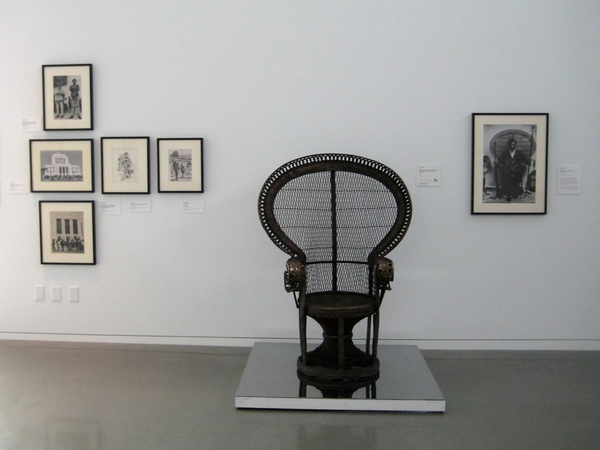
Sam Durant, Proposal for a Monument to Huey Newton at the Alameda County Courthouse, Oakland, CA, 2004. Bronze and steel, 58 x 48 x 48 in. Collection of the Oakland Museum of California, Gift of the artist and the Art Acquisition Fund.
The “Portrait Wall”, which forms the epicenter of the Gallery of Art’s People section, is an interactive installation that integrates works by acclaimed local and international artists such as Robert Arneson, Carmen Lomas Garza, David Park, and Carrie Mae Weems, with pictures made by OMCA visitors on a digital self-portrait drawing station. Once visitors have completed, saved, and even e-mailed their self-portrait, these drawings are transmitted to the two video screens embedded in the wall adjacent to the drawing station to join what René de Guzman describes as “a collective picture of California’s people.” As he then argues, the museum intentionally created this dense, salon-style hanging to celebrate the diversity of California’s community and show how artists from different generations have rendered this particular feature through their wonderfully divers work.

The “Portrait Wall”, an interactive installation located in the People section of OMCA’s Gallery of Art. Photo: Matthew Millman. © Oakland Museum of California.
Since its reopening in 2010, the Oakland Museum of California has featured tens of highly qualitative exhibitions, all of which explored the past, the present, and the future of California’s multifaceted reality from both a local and a global perspective. The combination of a charming architecture, an extraordinarily divers collection, a well-thought curatorial strategy, and a forward-thinking public program makes this museum, beside a unique exhibition platform, an essential instrument for social cohesion and cultural exchange.
A special thanks goes to René de Guzman, OMCA’s Senior Curator of Art, and Claudia Leung, OMCA’s Marketing and Communications Coordinator, for their essential support in the realization of this article.
by Diana Gadaldi
in A Walk Through The Art
Jan 22, 2014




